Developments in the field of automatic guns and ammunition
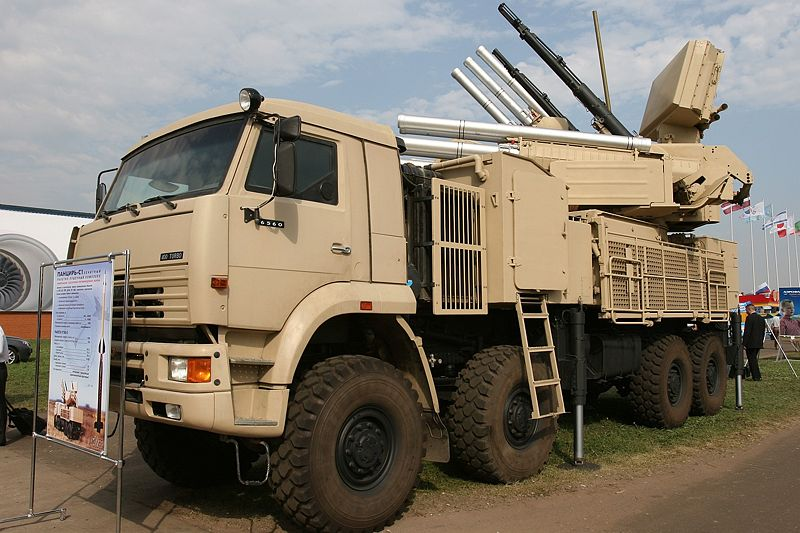
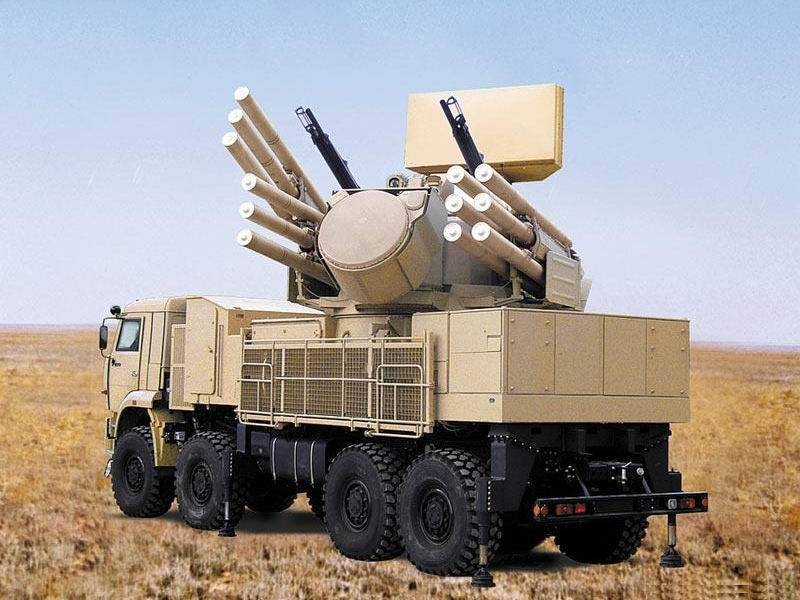
Ground-based anti-aircraft missile and gun complex armor, designed for the UAE army
The article presents an overview of the current state of affairs on the market for 20-57 mm caliber guns, related ammunition and gun mounts.
The appearance of guided munitions has played a decisive role in reducing the dominance of automatic cannons in service since World War II, but the development of new ammunition and even types of weapons will allow these guns to remain in the ranks for a long time.
In particular, there are four main tasks, where guns can still argue (this mainly concerns economic efficiency and partly combat capabilities) with missiles:
1) short-range defense (both ground-based and ship-based) against attacks of airplanes and guided missiles, as well as the fight against missiles, artillery shells and mortar ammunition of the enemy;
2) fire support and armor-piercing effects when installed on armored combat vehicles;
3) fighting small maritime targets;
4) and bombardment of the ground with a strafing flight.
Middle Air Defense
Guns still have advantages in the last level of defense, because their minimum range actually tends to zero and they have high firing rate and relatively inexpensive ammunition, while their high-speed projectiles reach the target in the shortest time. In order to actually use these advantages, modern guns are usually installed in complex gun installations with a fire control system (LMS) that can automatically detect, track and seize a target with minimal or no human involvement in the case of anti-missile systems.
There are two approaches to this task: in the first (systems of 20-30 caliber mm) guns with extremely high rate of fire are used, which in ship-based design, as a rule, shoot bursts of armor-piercing sub-caliber projectiles (BPS) with a tungsten core. In the case of ground-based missile intercept, artillery shells and mortar ammunition, shots that did not hit the target can fly several kilometers, creating an unacceptably high risk of indirect losses, so instead of BPS, self-detonating shells with a high-explosive warhead are used here.
The first (and today the most common) in this class is the Raytheon Phalanx MK15 CIWS (close-in weapon system) complex, known as Centurion in the C-RAM configuration (intercepting unguided rockets, artillery shells and mines). The gun component of this complex is the General Dynamics M61 gun with a rotating block of six barrels. This gun with external power, firing ammunition 20x102 mm, appeared in 50-ies of the last century. The newest version of the Block 1B has heavier and longer trunks in order to use the maximum capabilities of the MK244 Mod 0 ELC (Enhanced Lethality Cartridge - increased lethality) sub-caliber ammunition at sea, increasing combat effectiveness in the fight with small ships and helicopters, as well as more traditional for similar complexes purposes.
The Centurion complex shoots GD-OTS’s M940 MP-T-SD universal ammunition, which is a semi-armored high-explosive incendiary projectile that self-destructs after burning a high-explosive warhead with a tracer. Nammo has completed a conceptual development of an alternative C-RAM projectile with self-destruct, which is a combination of a small high-explosive charge with a tungsten core designed to destroy the attacking 155-mm artillery projectile.
Another only Western system that found its customers is the much larger Thales Nederland Goalkeeper, based on the GD-OTS GAU-8 / A seven-barreled rotary cannon, firing 30XXNNXX mm MPDS (punching missile-piercing discarding sabot - piercing the missile, I used a missile, I used a rocket. pallet), which was adopted on a much smaller scale.
AHEAD projectile cutter and fuse installer primed to the choke
The Russian industry has developed several anti-aircraft missile systems, one of which is the massive 3M87 Kortik / Chestnut developed by KBP - combined two 30-mm cannon GSH-6-30P with a rotating block of six barrels and eight 9M311 guided missiles to provide a two-level XNUMXMXNUMX gun with the aim of providing a two-level rotor one installation, which reflects the flexible concept adopted for such ground-based air defense systems, such as the Tunguska and the Armor.
In China, Russian systems were mainly adopted, but local systems were also developed there, for example, the ship Type 730B installation. It resembles the Goalkeeper complex, its seven-barreled gun is most likely based on the GAU-8 / A, but it also has the standard Russian caliber 30xXNNUMX mm. Also available is an option under the designation LD165, mounted on a self-propelled chassis.
The latest Chinese development, from which the cover of secrecy was torn off, is the formidable 11-barrel version of this cannon in the ship's design, mounted on the Liaoning aircraft carrier of the Varyag class. The declared rate of fire of the gun is 10000 shots per minute.
Another approach to air defense cannon defense is the use of guns of larger caliber 35 mm and more, firing projectiles that detonate near the target using a remote or temporary fuse. The capabilities of these systems vary considerably, only the most sophisticated and advanced are capable of attacking attacking missiles.
A typical near-air defense system that uses a similar approach is the Millennium Complex from Rheinmetall Waffe Munition (RWM), based on the Oerlikon KDG 35-mm four-rifle revolver cannon firing AHEAD (Advanced Hit Efficiency And Destruction) - an effective hit and destruction efficiency. 1000 fire rate / min. The complex is in service in the sea and terrestrial versions, including the C-RAM version under the designation MANTIS, adopted by the Germans.
The AHEAD remote ammunition fuse is programmed by the fuze installer when the muzzle projectile is fired in order to explode directly in front of the target and discard the “cartographic charge” of 52 tungsten balls of l3,3 grams in a XNUM meter from the point of blasting.
Without taking into account the many existing weapons systems in the world that are still used today, for the anti-aircraft missions, weapons of the 35 mm and 40 mm calibers are mainly proposed, the latter include the recently shown ship-mounted Bofors Mk 4. China is deploying two air defense systems using unique ammunition: a ship Type 76 caliber 37x240 mm and a towed PG87 dual system, firing ammunition 25x183B mm; Four of these 25 mm cannons are also mounted on the PGZ95 self-propelled tracked platform.
The practical value of the existing 25-35 mm caliber air defense systems was enhanced by the development of a thin-walled armor-piercing sabot projectile that has several advantages compared to traditional high-explosive ordnance. This sabot projectile has significantly improved ballistic characteristics, having a greater range of real fire and a higher probability of hitting at all ranges. The projectile differs from a conventional sub-caliber armor-piercing shot in that tungsten splits into shards after impact, having an impact comparable to that of a high-explosive fragmentation projectile. An additional advantage is that against lightly armored vehicles, it has almost the same efficiency as an armor-piercing sabot projectile, which turns it into a dual-use projectile and, at the same time, is safer to handle than a high-explosive type.
An unusual development in the field of air defense gun systems can be attributed to the new RAPIDFire complex from the French company Thales. A turret is installed on a ground-based self-propelled chassis with six short-range Starstreak guided missiles and a CTAS (Cased Telescoped Armament System) 40-mm cannon, firing telescopes with a remote fuse known as AAAB or A3B (anti-aerial air-burst). - against air targets, air blast). Perhaps the choice of a CTAS gun system for air defense is somewhat surprising, since it has a relatively low rate of fire of 200 rounds per minute. But it is designed to fight mainly with helicopters and unmanned vehicles (the secondary task is to fight ground targets), since missiles will help in the fight against faster targets.
Mounted on a Thales RAPIDFire self-propelled SAM chassis with an 40-mm 40 CTAS gun
Presentation of the RAPIDFire anti-aircraft system at an air show in Paris with Russian subtitles
Armored vehicle
As for combat armored vehicles (BBM), the cycle “armor - armor-piercing weapon"Forces the military to turn to more and more powerful guns and therefore what has traditionally been the unofficial standard NATO caliber - 25x137 mm ammunition fired from Oerlikon KBA, ATK M242 Bushmaster and Nexter 25M811 cannons - is being gradually replaced by 30xXNNXXNMXNNXXNNXXNNXXNNXXNNXXNNXX-NNXXNNXX-cannon guns. Mauser MK 173 and ATK Bushmaster II / MK30 series guns.
Some armies went even further: the Danish and Dutch armies selected the CV9035 BME from BAE Systems, armed with a Bushmaster III gun from the ATK caliber 35xXNNXX mm Oerlikon, while the British army was ready to install the CTA International 228X40 mm CTAS 255 telescopic ammunition system from the CTA International intelligence company with its new intelligence in its new reconnaissance system 40XXNUMX mm CTAS XNUMX from CTA International Scout SV and modernized BMP Warrior. The next candidate for installing this system is the EBRC machine of the French army.
The CTAS gun system is unique in that it uses a telescopic munition, in which the projectile is completely hidden inside the cylindrical sleeve, as well as a mechanism with a rotary chamber (stands coaxially with the barrel when each projectile is shot, but then turns sideways so that the next one is sent to it shell, and the fired cartridge case is thrown to the other side). The use of a transverse loading mechanism made it possible to obtain an extremely compact gun and feed mechanism. When mounted in a tower, they take up less space compared to the traditional 40 mm L / 70 Bofors cannon, variants of which are installed in the Swedish CV90 and the new South Korean tank K21.
ATK worked (initially with GD-OTS, and now independently) on the 40x180 mm version of the 30x173 mm munition. He is known under the designation Super 40 and occupies the same cylindrical volume. It requires replacement of the barrel and certain adjustments of the mechanisms for feeding and rolling back the XM813 gun, which is a modified version of the MK44 Bushmaster II. The new ammunition has an increased by approximately 60% mass of the high-explosive fragmentation warhead compared to the high-explosive fragmentation warhead of the 30 caliber mm plus a slight improvement in armor-piercing characteristics; but at this time there were no orders for it.
Russia re-equipped some of its PT-76 light tanks, having installed on them a new AU-220M turret with a C-60 gun still 50-s of development, but in a version of the mm 57X347SPR caliber. This weaponry was also proposed for the commercial French-Russian project for the Atom 8х8 infantry combat vehicle presented to the public in October 2013.
The preferred ammunition for the fight with enemy armored vehicles remains the well-proven feathered armor-piercing sabot projectile. He was constantly improved, but most of all he improved ammunition designed to increase combat effectiveness in the fight against enemy infantry. As an example of one of the approaches, an upgraded 35-mm version of the Oerlikon AHEAD / KETF (with ready-made striking elements and a remote fuse), which has a greater number of the same ready-made striking elements that are used in the 30-mm version, can be cited. An example of another approach is also an air blast with a remote fuse, known by the abbreviation HEAB (high-explosive air burst - high-explosive air blast) or PABM (programmable air burst munition - programmable air blast). Unlike AHEAD, it has a larger amount of explosive surrounded by a much larger number of smaller attack elements (GPE).
Instead of blasting close to the target, when most of the GGE is mainly flying forward (although fragmentation KETF was modified to get a wider spreading of the GGE), HEAB explodes directly above the target and releases most of its fragments radially at an angle 90 ° to the trajectory, increasing the probability of hitting personnel hiding in shelters or trenches.
On the other hand, KETF shoots forward more GGE with a much more concentrated impact on the target, which requires a less accurate time to undermine. Nevertheless, although several customers were found at AHEAD, HEAB seemed to attract more interest: the first swallow of the 30xXNNUMX mm caliber appeared in the form of a MK173 Mod 310 PABM-T projectile, but versions of the 0XX25 mm caliber were also being developed.
For several decades, Russian BBM light weapons have been armed with two 30-mm guns of caliber 30x165 mm: operating gas exhaust 2А42 and using recoil force 2А72. These guns are less powerful than Western caliber 30x173 mm. They shoot surprisingly conservative ammunition, which originally consisted of conventional high-explosive fragmentation projectiles with a nasal fuse and a full-caliber armor-piercing projectiles, although it was later presented with a tungsten core armor-piercing ammunition. To date, a feathered armor-piercing sub-caliber shot into the arsenal of the Russian army has not been received, but the need for ammunition with better characteristics is very large, since there are quite a lot of users of these guns all over the world.
Nammo cooperates with the Bulgarian Arcus (produces a line of ammunition 30x165 mm) as well as with the manufacturer of explosives for charges Nitrochemie Wimmis to meet the needs of Finland. Here you can include universal projectiles with self-destruct (semi-armor high-explosive incendiary tracer), training tracer, feathered armor-piercing subcaliber with tracer and armor-piercing subcaliber. Apparently, the obsolete armor-piercing sub-caliber was included in this list because the 2A72 cannon needs to be fired with heavy projectiles in order to get sufficient recoil force to operate the cannon’s mechanism, and the pierced-armored-piercing projectile with a tracer is too light for that. Another problem is that the 2A42 cannon is quite tricky in handling ammunition and they have to withstand it. This type of ammunition is currently being tested.
As an alternative to guns with growing fire power, ATK offers its chain-driven M230LF cannon with 30XXNNUMXB caliber mm. It is a variant of a medium-speed cannon mounted on an AH-113 Apache helicopter. It has a longer barrel and band feed and is designed for firing with cumulative fragmentation rather than armor-piercing types of projectiles, but since this gun is much lighter than guns (also ATK) of 64 mm and 25 mm, having a high initial velocity of the projectile, it needs lighter support (carriage).
At the Eurosatory 2014 exhibition, the M230LF gun was installed in the remote-controlled Lemur combat module from BAE Systems and at the AUSA exhibition in October 2014 on a Flyer lightweight special vehicle.
BMP CV9035 Mk III of the Dutch Army with a Bushmaster 35-mm automatic cannon from ATK Armament Systems
Sub-caliber ammunition Rheinmetall 30x173 mm. From top to bottom: training tracer with PMC 307 separating pallet; tracer feathered armor-piercing piercing slug PMC 287; thin-walled armor-piercing tracer with PMC 283 separable pallet
Surface targets
Combat operations in coastal areas and areas with low intensity of combat operations, especially in dangerous places or unfriendly ports, have contributed to the revival of interest in light cannon of maritime use. Such interest can be seen in the modernization of short-range complexes, for example, in the framework of the Phalanx 1B program, infrared guidance was implemented and the complex's capabilities were improved in the fight against hovering helicopters and small boats, or in the installation of specially designed gun systems with 20-30 less rapid-fire guns. As a rule, equipped with optical-electronic sights and increasingly remotely controlled.
As for the latter systems, the remote-controlled gun system Rafael Typhoon, adopted by several countries, has become particularly successful. Like other similar installations, it can accept a wide range of 20-XNUM mm caliber cannons, although usually it is chosen for it with an ATK M30 Bushmaster 25-mm cannon. So did the US Navy, which adopted the Typhoon installation in the MK242 3 Mod 8 version in order to replace the 2-mm MK25 Mod 38 installation, which had the same gun, but manual drives.
In a similar scenario, the DS30B hand-operated installation of the British Navy, created back in the 80s, is currently being replaced by a remote-controlled installation from the MSI Seahawk range, designated DS30M Mk2 ASCG (Autonomous Small-Caliber Gun - autonomous small-caliber gun). In it, the Oerlikon KCB 30x170 mm gun is replaced by the ATK MK44 30x173 mm gun. The interesting thing is that the rate of fire of the original 600-650 shots / min, which, when used with modern sights, gave the unit some anti-aircraft potential, dropped to the typical rate of fire of the 200 chain-drive guns / min, indicating that the emphasis was definitely shifted to direction of fighting much slower goals.
Perhaps the most unusual choice was made by German fleetwho chose the Rheinmetall MLG 27 rig to replace the manual 20mm and 40mm rigs. MLG looks like other stabilized combat modules, but at the same time it is very different, since it has aviation 27-mm BK 27 revolving gun with a fire rate of 1700 rounds / min, which gives the installation really good potential, although according to the manufacturer, the optoelectronics and FCAs are effective only against surface targets and helicopters within a radius of 2,5 km (up to 4 km against larger surface targets )
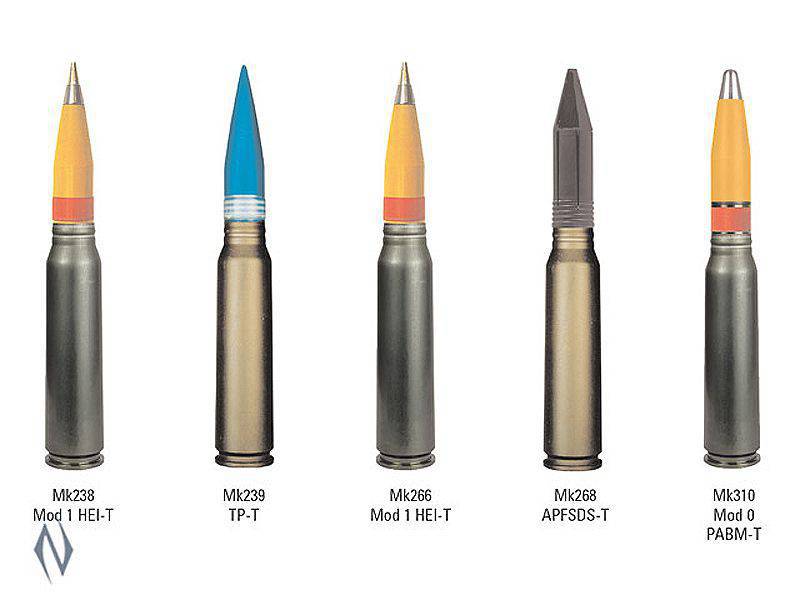
ATK 30xXNNMX mm ammunition line
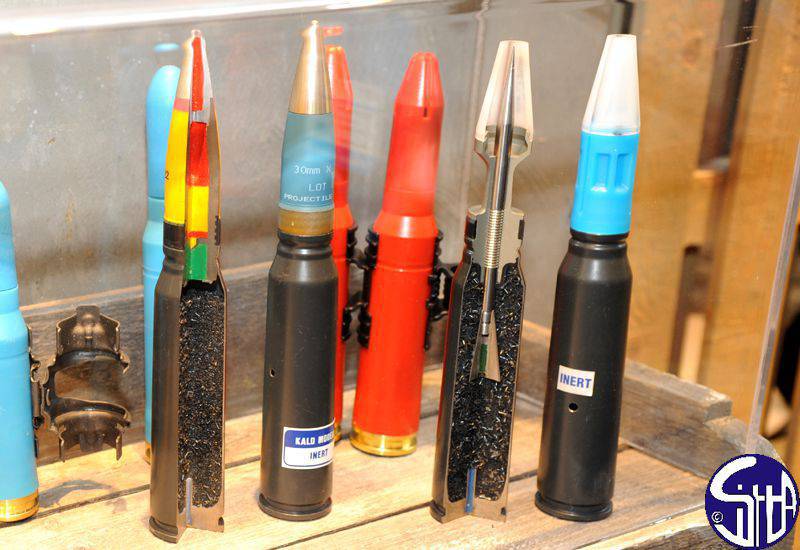
Nammo 30x173 mm Ammunition Line
The main types of ammunition used for these guns are mostly standard, high-explosive incendiary with a head fuse, or Nammo's universal semi-armor high-explosive incendiary, but again the difference between the MLG 27 installation is that it fires mostly thin-walled DM63 subaliber firearm.
The feathered armor-piercing sabot tracer MK258 Mod 1 "Swimmer" (Swimmer) was developed by Nammo in close cooperation with the US Navy. This new type of ammunition was adopted for the MK46 gun complex (a remote-controlled installation armed with the MK30 44-mm cannon), which was installed on the San Antonio-class landing ship LPD-17 and the new US Navy coastal defense ship. It differs from the traditional MK258 Mod 0 in that the projectile has a supercavitating bow, which, when fired into the water, creates an air bubble around the projectile, which significantly reduces drag. Nammo calls it “hydroballistic” ammunition.
As a rule, cannon shells quickly lose accuracy when entering the water and stop almost immediately, however, the Swimmer 150 gram projectile, shot at 1430 m / s, has 25 m / s after passing 1030 meters in water. It was originally developed for the canceled Navy RAMICS program (Rapid Airborne Mine Clearance System), in accordance with which the MK44 gun mounted on a helicopter would shoot into the water column to sink and detonate sea mines at depths up to 60 meters. Currently, he has confirmed his usefulness due to the ability to pierce the hull below the waterline or even shoot through the waves that obscure the small vessels.
Larger ship cannons provide more universal capabilities, since they are effective in dealing with larger ships, in addition, they can even provide some fire support to the coastline, as well as perform limited anti-aircraft guns. At the lower end of this category, you can put the 40-mm Bofors cannon, while its elder brother, 57 mm caliber, is on coastal defense ships and other types of ships of the American fleet.
Russia responded with a modern version of its 57-mm ship cannon, created back in the 50-ies, this time placing it in the A-220 gun mount. It is designed for ships of different projects and still should appear in service. According to some reports, the development of a Russian-controlled 57-mm projectile, which was reported several years ago, has not yet begun.
Aircraft Armament
Although the air force occasionally lost its love for cannons, most pilots recognized their usefulness and many settled on the 30 mm as an optimal caliber with the exception of a few European NATO members using the Mauser BK 27 turret gun with 27XNNMXB mm ammunition (standard for Tornado fighter, Typhoon and Gripen), and the operators of American fighters, which still have the M145 gun caliber 61x20 mm with a rotating block of six barrels, although currently firing more modern ammunition.
The US Marine Corps uses a GAU-25 / U 12 / U cannon with a five-barrel rotating block in its Harrier II AV-8B attack aircraft, but the new GAU ammunition 25X137 mm should be more widely used in aviation. -22 / A (lightweight GAU-12 / U with four barrels), chosen for the F-35 Lightning II fighter. This gun will be installed inside only the F-35A US Air Force, and will optionally be available in a removable turret for the F-35B STOVL (shortened take-off and vertical landing) and F-35C options for the US Navy.
The choice of ammunition for an aircraft gun is influenced by two limitations. First, planes, as a rule, cannot use sub-caliber ammunition because of the risk of strikes of pieces of the discarded pallet on the plane or getting them into the engine. Second, the volume limitations do not allow the installation of a dual power system, that is, the aircraft needs a single, universal type of ammunition.
At the Eurosatory 2014 exhibition, the Cockerill CPWS 30 remotely operated tower, equipped with a 30-mm ZTM-1 cannon (Ukrainian version based on the 2-72 cannon) was presented.
Russia seems to be an exception in this area, since it still uses the traditional combination of high-explosive, high-explosive and tracer and armor-piercing shells with a head fuse tucked into a shell ribbon. In the NATO Air Force, they were replaced by more advanced types of the main universal type base without a fuse from the company Nammo, a typical example here is the American gun PGU-28A / B caliber 20xXNNUMX mm. France is unique in its development mm).
In recent years, two more types of ammunition have achieved certain success: FAP (Frangible Armor Piercing - thin-walled armor-piercing) from Rheinmetall with a core of tungsten alloy, which is fragmented after impact; Diehl's PELE (Penetrator with Enhanced Lateral Effect - armor-piercing with improved side effects), which uses a combination of a thick outer steel body and a light inner core, after impact, fragments of the steel body fly at high speeds in all directions. Attacking elements can be added to shells of both types in order to enhance fragmentation. These munitions are effective against different types of targets; 20xXNNMX mm and 102x27B mm gauges are available. Both ammunition have inert projectiles, which simplifies the requirements for their transportation and handling.
An interesting tripartite rivalry is currently underway for the supply of ammunition 25x137 mm for the F-35 fighter.
The US Armaments Research and Development Center, in cooperation with GD-OTS, is developing a non-energy fragmentation projectile (NEF) based on the previous PGU-20 / U round with a core of depleted uranium placed inside the steel hull. PGU-20 (NEF) is fundamentally different in that it has a uranium core replaced by a tungsten alloy fragmented core. His tests are completed and qualification is underway.
RWM developed the 25-mm version of the FAP projectile qualified for the US Air Force, and General Dynamics Armament and Technical Products developed the US version of the PGU-48 / B designation for firing an F-35A cannon fighter.
Nammo created the APEX projectile, which, unlike the other two bidders, has a high-explosive fragmentation component with a fuse combined with a tungsten alloy punch in the bow. The development was funded by the Norwegian Defense Support Organization to meet the requirements of the Norwegian Air Force. This is the only projectile, which received the American designation PGU-47 / U, which is planned to certify for all three variants of F-35.
In the case of the F-35A, development is funded on an equal basis between Norway and Austria in collaboration with the US Air Force, flight tests are scheduled for the 2015-2016 years. In the case of the F-35B and F-35C, the US Navy will qualify and be certified in the 2017 year.
The problem with all aviation munitions is that they are intended to be exploded or fragmented after piercing the outer shell inside the aircraft or ground vehicle, so they usually work with a delay. However, in recent years, fighter guns were mainly used to fire at enemy personnel when shells burrow into the ground before the moment of detonation or fragmentation, which significantly reduced their combat effectiveness.
Russians paid attention to this problem decades ago by offering ammunition, which is basically similar to Oerlikon KETF ammunition with ready-made attack elements, except that its delayed detonator is programmed in advance and not in the installer on the muzzle, so you need to open and stop fire in a certain range of distances. Although the ammunition is advanced as a means of destroying planes in the parking lot and similar targets, it is no less effective in anti-personnel tasks than air-assisted ammunition such as KETF or PABM, of course, subject to adaptation of the SLA for firing from an aircraft. In the fight against the infantry, you can also use a proximity fuse. In this regard, in the framework of the ARDEC program to develop a single fuse technology, the proximity fuze for 30x113B mm ammunition for the Apache helicopter gun was tested, which could increase efficiency in the fight against enemy manpower. If successful, this technology could be implemented in munitions intended for fighter guns, but it is unlikely that this would be appropriate for such a small caliber as 20 mm.
Finally, the 25-mm GAU-12 / U and the 40-mm L / 60 Bofors, installed on the American gunships (the ganship is an armed transport plane) AC-130, were replaced with the 30-mm GAU-23 gun (upgraded ATK MK44), shooting mainly developed by ATK high-explosive fragmentation projectile PGU-46 / B with a head fuse and low aerodynamic drag. The new development - the “lightweight gunship” AC-235 - is armed with a lighter and less powerful ATK M2 30LF gun.
In the light of current development and the obvious combat capabilities offered by guns, in the foreseeable future, they are likely to restrain the onslaught of missile technologies.
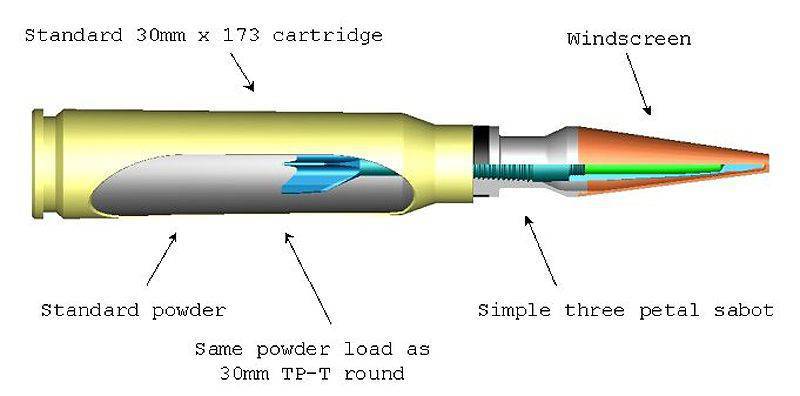
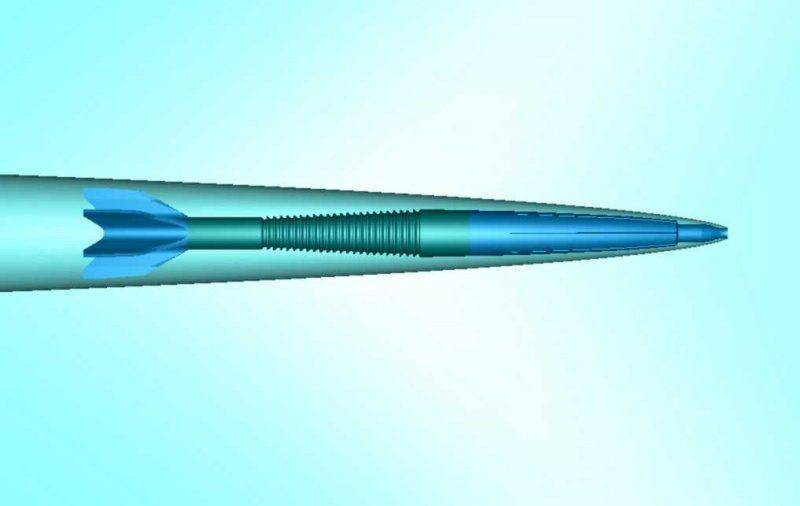
Drawings for the Swimmer 30-mm “Hydroballistic” Projectile
Materials used:
www.janes.com
www.raytheon.com
www.kbptula.ru
www.thalesgroup.com
www.rheinmetall.com
www.nammo.com
www.baesystems.com
www.atk.com
www.saabgroup.com

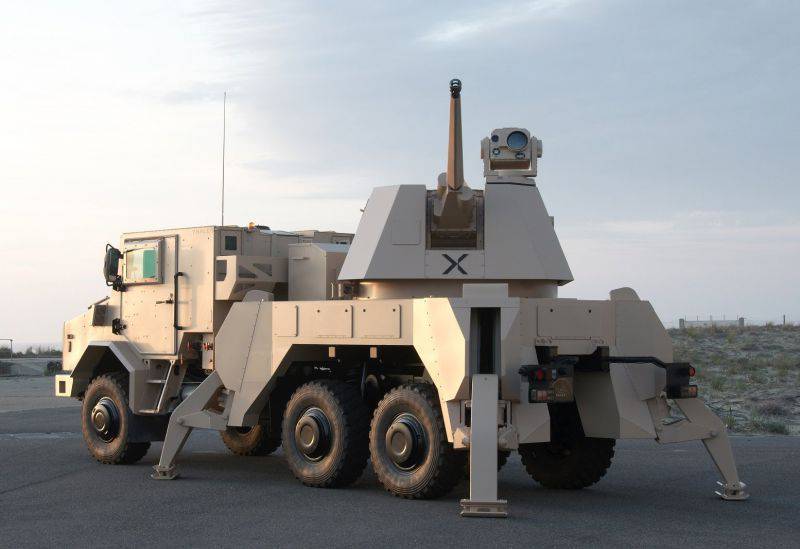
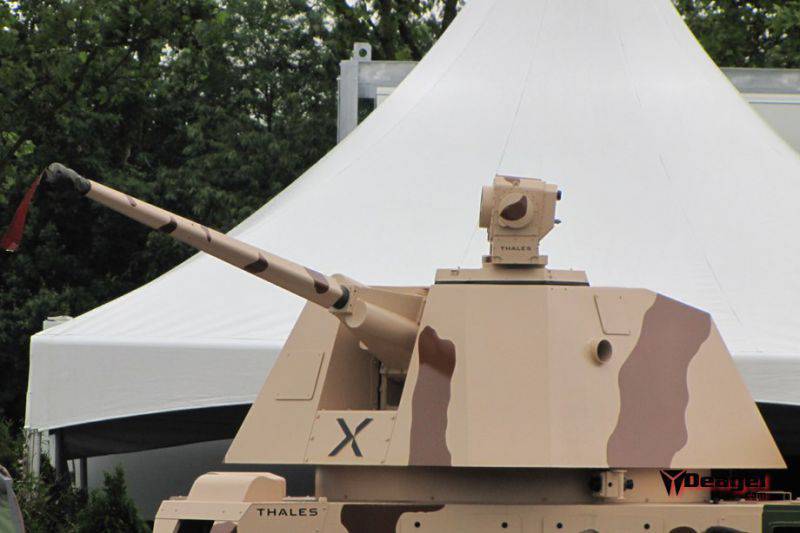
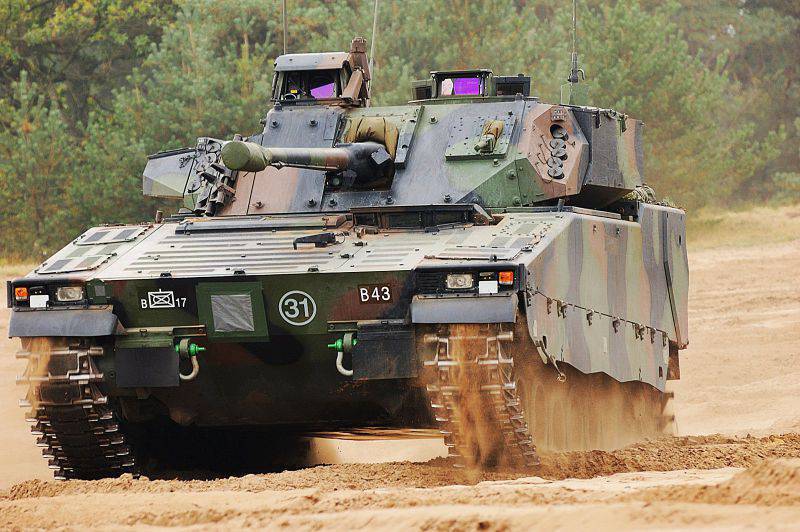
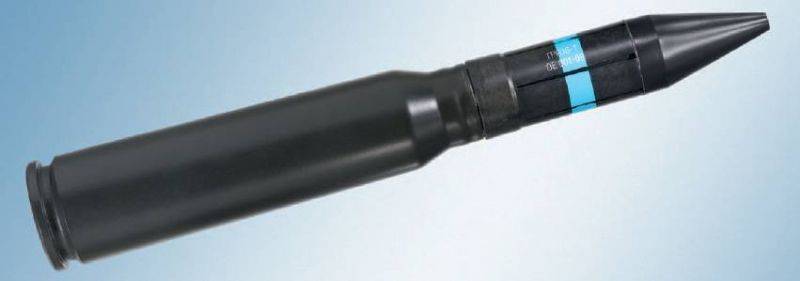
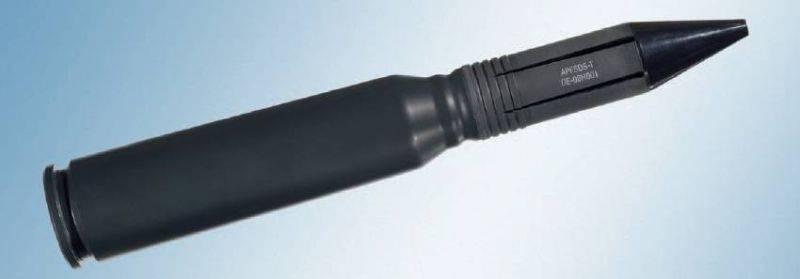
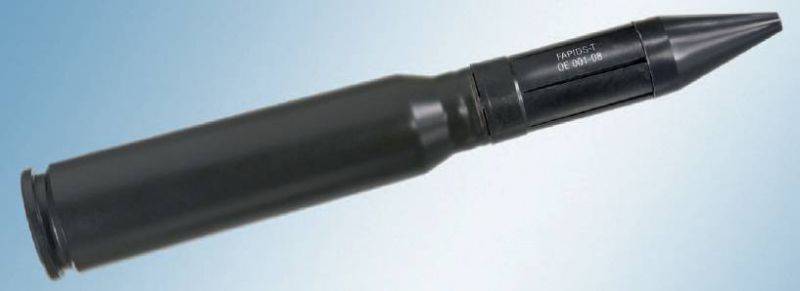
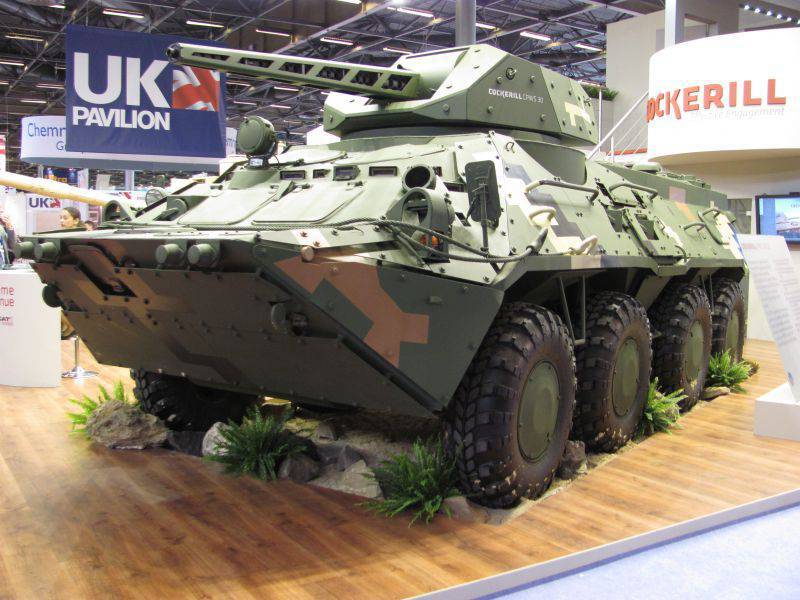
Information